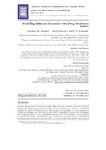| dc.description.abstract | Despite improvement in medical and public health standards, influenza continues to plague humankind causing high morbidity,mortality and socio-economic cost. Efforts to effectively combat the spread of influenza can be put in place if its dynamics are well understood. Numerous challenges have been faced in the event of controlling the spread and eradicating this contagious disease, a major impediment being the rise of drug resistance. In light of this, a deterministic model is formulated and used to analyze the transmission dynamics of influenza having incorporated the aspect of drug resistance. A system of differential equations that models
the transmission dynamics of influenza is developed. The effective reproduction number (Re) and the basic reproduction number (R0) are calculated.For this model,there exists at least four equilibrium points. The stability of the disease free equilibrium point and endemic equilibrium point is analyzed. Results of the analysis show that there exists a locally stable disease free equilibrium point, E0 when Re < 1 and a unique endemic equilibrium E∗, when Re > 1. Sensitivity analysis is carried out to determine parameters that should be targeted by intervention strategies. The effect of drug resistance and transmission rate of the resistant strain on the infected and the recovered is discussed.Results show that development of drug resistance and transmission of the resistant strain result in widespread of the resistant strain. A decrease in either of these two factors leads to a significant reduction in the number of infected individuals,hence, social distancing can be used as an intervention mechanism to curb the spread of the resistant strain | en_US |

